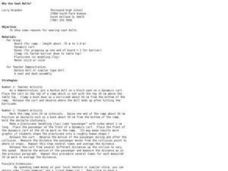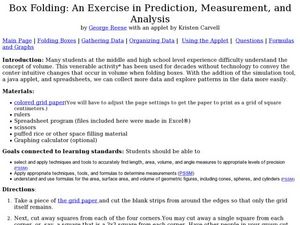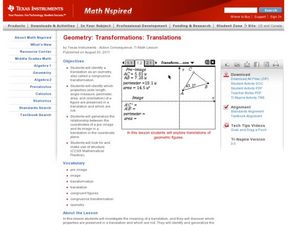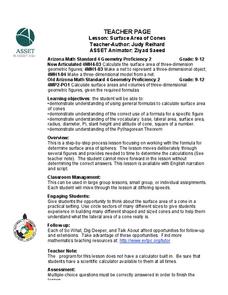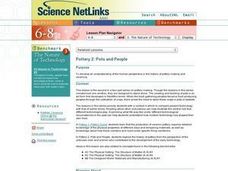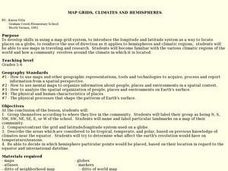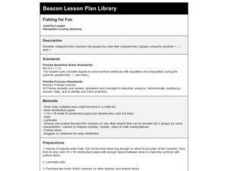Curated OER
Radioactive Decay
Students explore radioactive decay. Through various activities, students examine methods for permanent disposal of radioactive waste. After performing a random process experiment, students compare the results to radioactive decay. ...
Curated OER
Games with a Large Parachute
Students control the parachutes using arm movements. They follow directions while participating in games. They explore the effects of wind on several objects and study the effects of shape, size and weight on a parachute.
Curated OER
Parachutes
Young scholars control the parachutes using arm movements. They follow directions while participating in games. Students explore the effects of wind on several objects. They study the effects of shape, size and weight on a parachute.
Curated OER
Mapmakers' Perspective
Students examine several maps and consider mapmakers' perspective in early depictions of North America.They determine how the spherical shape of the earth makes any north-south and east-west orientation a matter of perspective. For...
Curated OER
Planetary Orbit
Students compare and contrast ellipses of various eccentricities that represent the shape of planetary orbits. They make a circle with the string by trying the two ends togther. Students calculate the eccentricity of their ellipses by...
Curated OER
Sponges, Cnidarians, Flatworms, and Roundworms
In this simple animals worksheet, high schoolers compare and contrast the body plans of sponges, cnidarians, flatworms, and roundworms. This worksheet has 4 short answer questions.
Curated OER
Cellular Transport
In this cellular transport worksheet, students review the process of osmosis and compare passive transport and active transport. This worksheet has 12 matching questions.
Curated OER
Why Use Seat Belts?
Students explore reasons why using a seat belt is a safe choice while riding in a car. In this physics/safety lesson, students set up and observe a doll with and without a seat belt moving down a ramp in a dynamics cart. Collision...
Curated OER
Earthquakes
Students observe the melting of ice. In this phase change lesson, students observe ice as it melts. They discuss the process and create a Venn diagram comparing water and ice.
Curated OER
Activity: Bird Beak Buffet
Students study the functions of bird beaks. In this animal evolution lesson, students compare and contrast different types of bird beaks focusing on how the beaks are adapted to the foods the birds eat. Students record and graph their...
Curated OER
United States Map
Students compare the United States on a globe and on a map. In this map lesson, students relate the sizes of the continents and locate the United States. Students identify the location of the continental US as well as Alaska and Hawaii.
Curated OER
If you have to find the area of a region, how would you calculate it?
Fifth graders find the area of rice farms. In this area lesson plan, 5th graders draw shapes and grid them to find the area. They compare different rice fields to see which one takes up more space and has the larger area.
Curated OER
Box Folding: Predict, Analyze and Measure
Students predict the shape of a geometric figure in 3D. In this geometry lesson, students construct 3D shapes to perfect their knowledge of measuring and predicting. This assignment is also available as an online interactive lesson.
Curated OER
Transformations-Translations
Students perform transformations and translation on a coordinate plane. In this geometry lesson, students move shapes around on a graph identifying translation, image, and transformation. This lesson has an interactive part online that...
Curated OER
Applied Science-Science and Math Lab
Learners explore magnification. In this scientific observation skills lesson plan, students observe sea life items and draw pictures of what they observe. Learners predict which lens will have the strongest magnification when given three...
Curated OER
Surface Area of Cones
Students find the surface area of cones. In this geometry lesson, students calculate the dimensions of each three-dimensional shape and use the correct formula to solve the problem. They relate concepts of cones to the real world.
Curated OER
Math: Will The Airplane Get Off the Ground?
Students use data from real-life models to calculate and compare the force required for an airplane of a given weight to become airborne. They use a graphing calculator to evaluate data and use the World Wide Web to access data.
Curated OER
Actual Airflow vs. Ideal Airflow: Stalls
Students use 3-D modeling techniques to observe the characteristic signature of the stall condition apparent on an airfoil at high angles of attack. They use FoilSim to compare the above with ideal airflow.
Curated OER
Controlling the Flow of the Colorado River: A Study of Dams
Students research and map the Colorado River and its dams and predict the effects of a dam on an area. They suggest reasons a dam would be built and compare the Colorado River system with other major river systems within the US and...
Curated OER
Pots And People
Students compare present technology with that of earlier times. They explore the history of pottery from the perspective of the unknown men and women who contributed to the development of the early technology.
Curated OER
MAP GRIDS, CLIMATES AND HEMISPHERES
Young scholars compare/contrast the grid and latitude/longitude system used on a globe. They describe the areas which are considered to be a tropical, temperate, and polar, based on knowledge of climates.
Curated OER
Fishing For Fun
Second graders categorize fish crackers into groups by color and compare the two groups using the symbols <, =, and >. They use concrete objects to solve number sentences with equalities and inequalities.
Curated OER
How Does Climate Affect Plant Growth?
First graders compare plant samples obtained from two different sites to explore how climate affects plants.
Curated OER
Making a Rock Collection, Lesson 1
Learners discover the different shapes and sizes of rocks. They create a chart on what they already know about rocks and sort rocks by size. They place cutouts of rocks on construction paper from smallest to largest.









